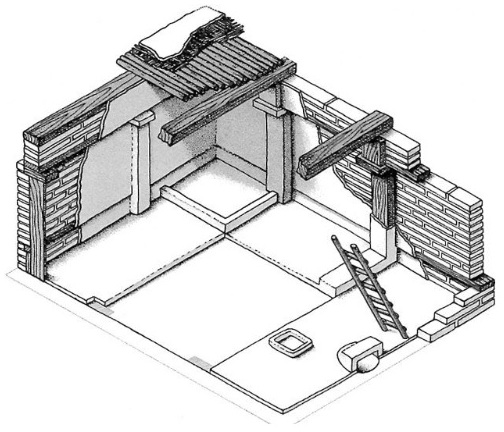Garner
Garners are half-timbered buildings that serve as temporary granaries during harvest times, as exchange points between farmers with their produce and carters who carry it away to markets. In temperate climates, they only see use from late July until the first week of December; they're not ordinarily used to store food through the winter, spring and early summer. Garners are important buildings in thorps and hamlets; they occur as auxiliary buildings around granaries in larger centers, specifically for use during the harvest glut.
The term "garner" also describes the owner and operator of the building, who acts as collector, accountant and caretaker of local agricultural supplies. The profession is commonly applied as a surname, such as "James the Garner" or "Jennifer Garner."
The population supported by a garner equals 2d4-1.
Construction
Garner buildings vary in size, with the smallest and most common being some 25 ft. by 15. The ratio of stone to wood varies, but in every case the garner floor is constructed of paving stone and mortar, or fashioned of cement. The floor is stepped to ensure drainage in case of flooding. The lowest four feet are stone wall of broken stone, mortared but riddled so as to ensure easy evaporation to the outside. The upper walls are timbered, with a peaked roof protected by bark shingles. One or more square troughs are built of stone and wood framing to store loose vegetables or grain.
Larger garners include an inside threshing floor, though it's more common to find one immediately outside. Auxiliary storage sheds, for fruit or large vegetable produce, such as pumpkins, may be attached to the garner proper or be located nearby.
Function
Most independent farmers are unable to haul their produce to a village more than eight miles away, and therefore depend upon the garner. Goods are delivered, measured and if necessary threshed by the farmer, the garner or temporary labour as demand rises. The farmer is then paid by signed voucher, to be remunerated by an agreed-upon third party villager. Live animals and other farm produce isn't handled by a garner; these things must be delivered direct to villages.
The garner has arrangements with carters, who collect the produce throughout the harvest season and deliver it to carter posts or direct to town markets. The carter presents a signed voucher for a set amount of produce, which the garner then provides. Thus no money exchanges hands, preserving the operation from threat by bandits.
Garners may altenatively be supported by boat docks, so that goods are moved over water rather than by cart or wagon. Where no road exists, and carts cannot be used, goods are carried out by goaders who drive oxen, requiring a nearby ox tether.
The garner dwells nearby with his or her family, who spend much of the year sewing burlap or canvas sacks, or weaving baskets, into which are transferred mainly animal feed and cereals. Fruit and vegetables are commonly brought to the garner and hauled away as loose goods. As the season comes to a close, with the last carter, whatever remains must be taken by the garner personally to a town market and sold. The winter is spent making repairs, building additions and balancing accounts. The garner and family spend the spring and summer tending their own garden, orchard or fields.
Services
From the end of July until the end of November, garners are willing to sell cereal grains, fruit, vegetables and animal feed to passersby, thus acting as a purchasing outpost for adventurers or hunters far afield from town. Barter is preferred to the use of coin, especially the exchange of meat for less desirable staple foods. The price depends on local prices within the province, but any good provided by a garner can be bought at 50% of cost.
Nonetheless, a garner must reserve sufficient stores to meet his or her commitments to merchants, so a limit of 40 lbs. of food is imposed per week.
See also:
Hammer (symbol)
The Adventure
Type-7 Hex
